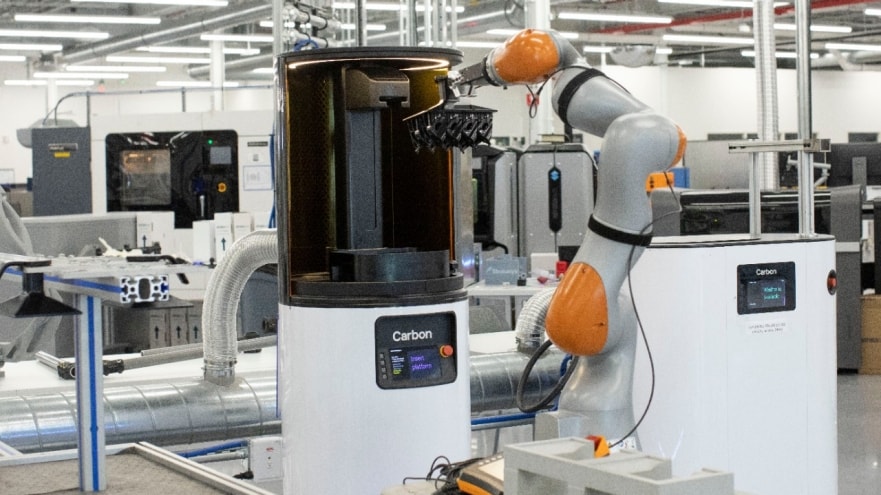Collaborative robots are very much in demand now but they often lack the systems to integrate well with existing automation and processes. Now however, Ford reports that it has a roving KUKA robot, affectionately named Javier, to run its 3D printers. This could be a boon for the Dearborn-based automaker.
Javier roams around and can autonomously remove builds and communicate with the company’s 3D printers. The auto manufacturer has developed a system that allows Javier to “talk” to equipment from several different suppliers, which will aid its further automation efforts. In one example, Ford’s Carbon printers use an API to tell the KUKA bot when to recover parts from the printer. If the company’s claims are true, then the KUKA bot could also easily be trained to work with the Fortus and other Stratasys systems seen in the picture below (J850 and F270s, perhaps?).

Image courtesy of Ford.
“This new process has the ability to change the way we use robotics in our manufacturing facilities. Not only does it enable Ford to scale its 3D printer operations, it extends into other aspects of our manufacturing processes this technology will allow us to simplify equipment and be even more flexible on the assembly line,” said Jason Ryska, director of Global Manufacturing Technology Development at Ford.
The company also states that the robot does not require machine vision and that is has filed for patents around the collaborative communication aspect of this development. The company thinks that the use of Javier would drive down part costs and increase throughput. So far, Ford is using Carbon 3D printers and the KUKA bot to produce niche or custom parts, such as the brake line bracket for its Performance Package-equipped Mustang Shelby GT500.

Carbon M3 3D printers. Image courtesy of Carbon.
This is a fantastic development by KUKA and Ford. If it could be easy to reprogram this robot and make it communicate to other automation equipment, then the firms could have a very versatile automation solution on hand here. New production equipment such as 3D printers could then easily be adopted across current factories and lines. They would not have to adapt an entire line to function with 3D printers in a series or batch but could instead add them to existing workflows. Should the company then have to switch to a new printer model or one from a different vendor, then it would be less expensive for them to do so.
This could also help Ford stay ahead of the innovation curve and always deploy the latest equipment. Rather than have to revamp entire lines and factory floors, this will lead to a supremely low-cost and potentially fast way for method to adopt new technologies. If the system works as advertised, then it could potentially be used for more conveyancing tasks, such as taking parts to be cleaned, flashed, or finished, as well.
With approximately 30 percent of 3D printing a part currently found in labor, this could add up to significant savings for many firms. A reduction in the use of machine vision might also cut costs on machine vision chips and components, making both KUKA and Ford less dependent on machine vision FPGAs, LIDAR and other in-demand technologies for industrial automation.
This seems to be, especially for KUKA, a prescient move now that we all understand how painful it can be to be at the back of the waiting list for in-demand chipsets. This is especially timely for the robotics firm, since the fact that the German stalwart is owned by the Chinese firm Midea is leading to doubts about how its robots can be safely used in defense, aerospace, and beyond. Lack of machine vision may assuage some firms and a versatile bot like this could be used in many factories where prying eyes are less of a concern.
So far in 3D printing, vendors have looked to make completely automated lines directly from machine to machine. This is capital-intensive and requires a lot of work. Furthermore, a delay anywhere in the line can back up the entire manufacturing operation. Here, robots or other equipment convey batches of a build from one printer to a depowering station to a finishing station and onward to production. In that case, equipment such as AM-FLOW then sort parts as entire builds pass through the process. Batch-to-batch processing is an attractive prospect. Now, however, Ford and KUKA have shown us that a system that is perhaps more involved and expensive per action but far more versatile in general is possible. This will be an interesting space to watch for us that could have significant impact on our market.
Subscribe to Our Email Newsletter
Stay up-to-date on all the latest news from the 3D printing industry and receive information and offers from third party vendors.
You May Also Like
IperionX Inks 10-Year Deal with Wisconsin Manufacturer for 80 Metric Tons of Titanium Per Year
IperionX, the Charlotte-based supplier of sustainable titanium powders used for additive manufacturing (AM) and metal injection molding (MIM), has signed a ten-year deal with United Stars, a group of industrial...
Gastronology Launches Industrial Production of 3D Printed Food for Dysphagia Patients
Food 3D printing has, in many ways, been an additive manufacturing (AM) segment looking for the right business case. While some applications are beautiful and others may or may not...
Lockheed Martin Leads $3M Investment in Q5D’s Electronics 3D Printing System
Q5D, an original equipment manufacturer (OEM) of robotic arm, hybrid additive manufacturing (AM) systems used for wire harness production, has closed a $3 million investment round. The investment arm of...
3D Printing News Briefs, April 6, 2024: Depowdering, Cybertruck Door Handles, & More
In today’s 3D Printing News Briefs, ioTech’s digital manufacturing CLAD technology is opening up opportunities for microelectronics and additive manufacturing. Hexagon and Raytheon Technologies commercially released the Simufact Additive Process...































